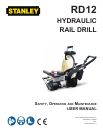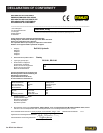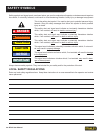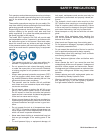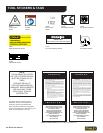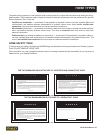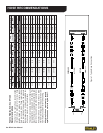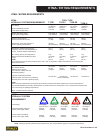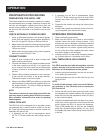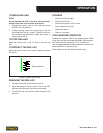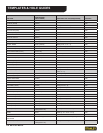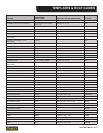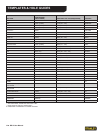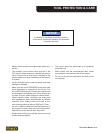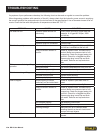
RD12 User Manual ◄ 5
SAFETY PRECAUTIONS
Tool operators and maintenance personnel must always
comply with the safety precautions given in this manual
and on the stickers and tags attached to the tool and
hose.
These safety precautions are given for your safety. Re-
view them carefully before operating the tool and before
performing general maintenance or repairs.
Supervising personnel should develop additional pre-
cautions relating to the specific work area and local
safety regulations. If so, place the added precautions in
the space provided in this manual.
The model RD12 Hydraulic Rail Drill will provide safe
and dependable service if operated in accordance with
the instructions given in this manual. Read and under-
stand this manual and any stickers and tags attached
to the pressure washer and hose before operation. Fail-
ure to do so could result in personal injury or equipment
damage.
• The operator must start in a work area without by-
standers. Flying debris can cause serious injury.
• Do not operate the tool unless thoroughly trained
or under the supervision of an instructor. Establish
a training program for all operators to ensure safe
operation.
• Always wear personal protection equipment (PPE)
such as goggles, safety shoes, head, eye, breath-
ing, and ear protection when operating the tool. Use
gloves and aprons when necessary.
• The operator must be familiar with all prohibited
work areas such as excessive slopes and danger-
ous terrain conditions.
• Do not inspect, clean or replace the drill bit or any
part(s) if the hydraulic power source is connected.
Do not inspect or clean the tool while the hydraulic
power source is connected. Accidental engagement
of the tool can cause serious injury.
• Always connect hoses to the tool hose couplers be-
fore energizing the hydraulic power source. Be sure
all hose connections are tight and are in good con-
dition.
• Do not operate the tool at oil temperatures above
140 °F/60 °C. Operation at higher temperatures can
cause higher than normal temperatures at the tool
which can result in operator discomfort.
• Never wear loose clothing or unrestrained long hair
that can get entangled in the working parts of the
tool.
• To avoid personal injury or equipment damage, all
tool repair, maintenance and service must only be
performed by authorized and properly trained per-
sonnel.
• The hydraulic circuit control valve must be in the
OFF position when coupling or uncoupling the tool.
Wipe all couplers clean before connecting. Failure
to do so may result in damage to the quick couplers
and cause overheating. Use only lint-free cloths.
• Never transport or carry the tool with the unit ener-
gized.
• Use proper lifting techniques when handling the
tool. Do not overreach. Maintain proper footing and
balance at all times.
• Keep hands and fingers away from rotating parts.
• Do not operate a damaged, improperly adjusted or
incompletely assembled tool.
• Do not exceed the rated limits of the tool or use the
tool for applications beyond its design capacity.
• Always keep critical tool markings, such as labels
and warning stickers legible.
• Check fasteners tightness often and before each
use daily.
• Never operate the tool if you cannot be sure that
underground utilities are not present. Underground
electrical utilities present an electrocution hazard.
Underground gas utilities present an explosion haz-
ard. Other underground utilities may present other
hazards.
• Always replace parts with replacement parts rec-
ommended by Stanley Hydraulic Tools.
• Warning: hydraulic fluid under pressure could cause
skin injection injury. If you are injured by hydraulic
fluid get medical attention immediately.



